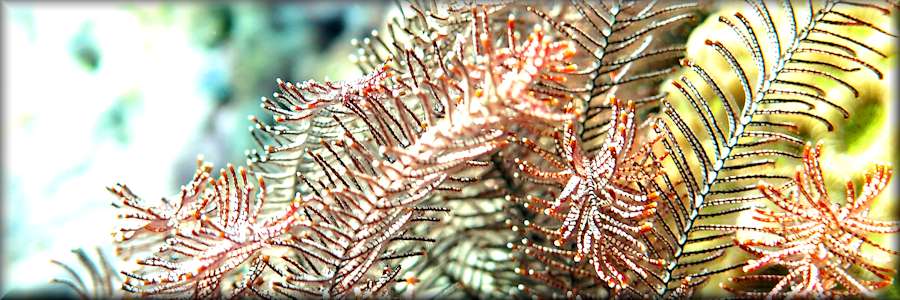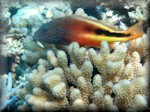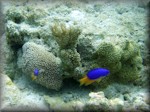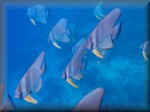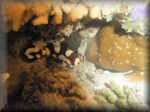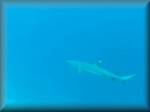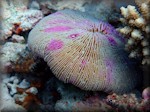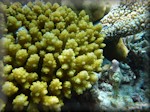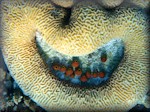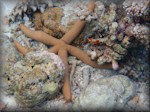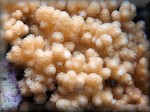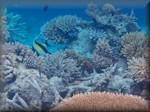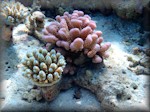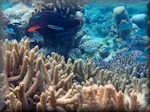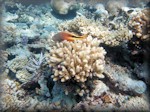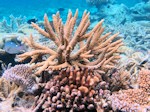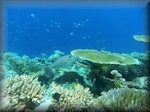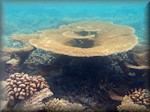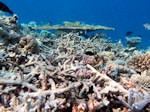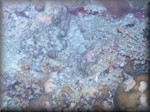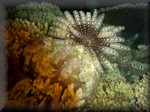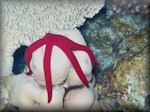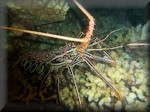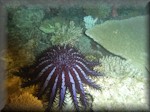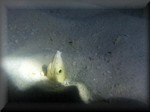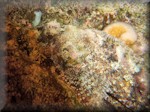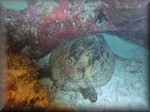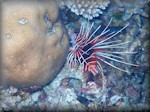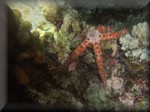Best Snorkeling in the Maldives for underwater photography
Banyan Tree - Vabbinfaru - North Ari Atoll - The Maldives
An established 5-star resort with a focus on it's environment
East side of North Ari Atoll (west by south of the Maldivian capital, Male).
20 minutes by speedboat from Maldive's Ibrahim Nasir International Airport.
20 minutes by speedboat from Maldive's Ibrahim Nasir International Airport.
We visited the Banyan Tree twice while staying on the adjacent sister resort island of Angsana
Ihuru.
One visit was a snorkel lasting well over an hour around half the island.
One visit was a snorkel lasting well over an hour around half the island.
The other was an half and a half night snorkel guided by the friendly, very knowledgable, Moosa.
The 5PM feeding of stingrays off the beach is a highlight. Each is known individually by name.
The 5PM feeding of stingrays off the beach is a highlight. Each is known individually by name.
Gallery below of close-ups of fish and critters you're likely to encounter at Vabbinfaru.
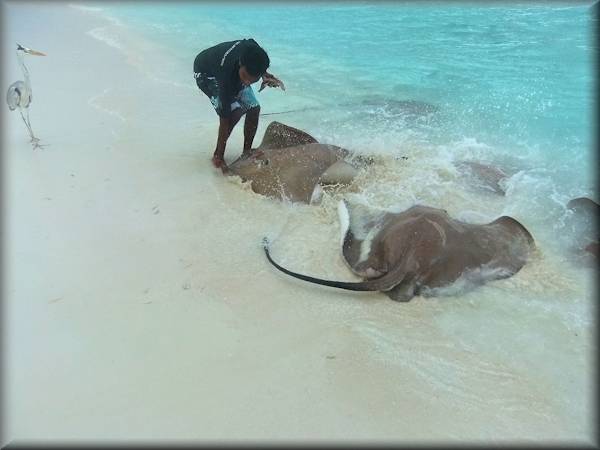
pass cursor over thumbnails left and right to see what is under the surface at Banyan Tree resort
Gallery below with shots to give an idea of the seascape at Banyan tree.
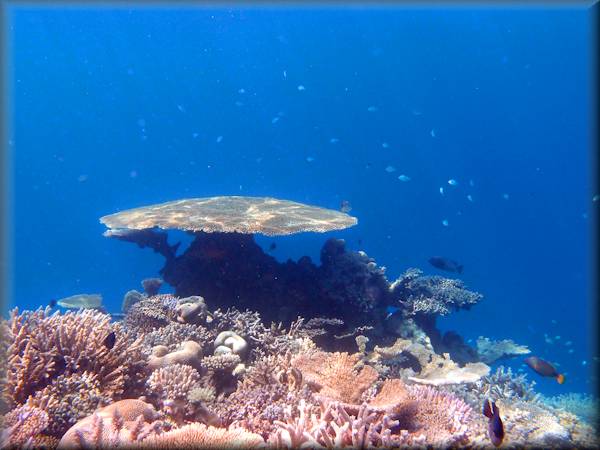
pass cursor over thumbnails left and right to see what is under the surface at Banyan Tree
Gallery below with shots to give an idea of what the night snorkel is like at Banyan tree.
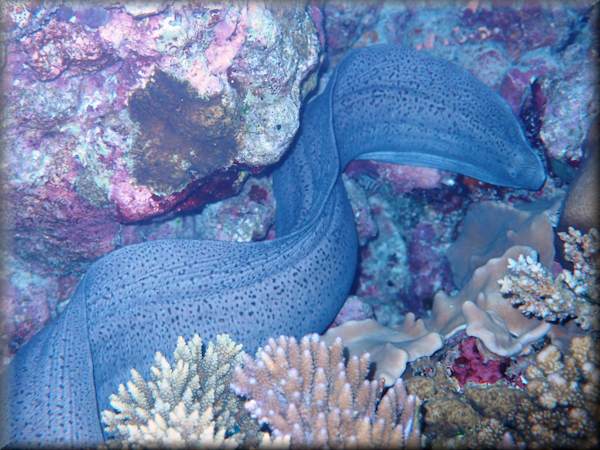
pass cursor over thumbnails left and right to see what it's like at night at Banyan Tree
As we only visited, rather than stayed at, the Banyan Tree, we are lacking photos for the usual resort
gallery and any in-depth report.
Vabbinfaru is a small island (100 x 85 metres).
It's the same size as the adjacent, sister island, of Angsana Ihuru. Angsana is the more recently built resort and appears to be more modern. Both resorts are run by the same company.
Vabbinfaru is a small island (100 x 85 metres).
It's the same size as the adjacent, sister island, of Angsana Ihuru. Angsana is the more recently built resort and appears to be more modern. Both resorts are run by the same company.
The latter is the older of the two resorts but this is not to say
that it lacks style.
The Banyan Tree resort has 48 villas. 15 minutes and you can walk around it.
From what we saw, the resort fits it's luxury billing and as is run by the same company, we expect the food and service to be of a high standard.
The Banyan Tree resort has 48 villas. 15 minutes and you can walk around it.
From what we saw, the resort fits it's luxury billing and as is run by the same company, we expect the food and service to be of a high standard.
There is a free boat taxi (10 minutes) between the two islands so allowing
snorkelling on both.
Banyan has it's 5PM stingray feed.
It is licensed to receive baby turtles from other islands to raise to a bigger size, to give them a much better chance of surviving to adult-hood upon their release.
Banyan has it's 5PM stingray feed.
It is licensed to receive baby turtles from other islands to raise to a bigger size, to give them a much better chance of surviving to adult-hood upon their release.
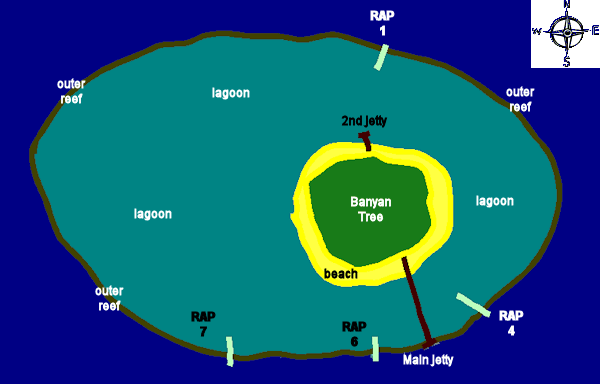 importantly, 4 reef access points (RAPs)
importantly, 4 reef access points (RAPs)
The two jetty's allow easiest access into the lagoon (or off the beach) and head for nearest Reef Access
Point (RAP).
At both snorkels, strong Westerly current so ...
Day swim - entered RAP 1, turned left and emerged at RAP 7. Current lessened from about 10 o'clock point and lagoon widens but visibility seemed to deteriorate.
At RAP 1 outer reef well defined, with much plate coral.
Seemed less defined as go towards say 9 o'clock and further around. Well defined again by Rap 6 with pick-up in current.
Judging from Google earth, reef is likely to be well defined in the Eastern quarter.
At both snorkels, strong Westerly current so ...
Day swim - entered RAP 1, turned left and emerged at RAP 7. Current lessened from about 10 o'clock point and lagoon widens but visibility seemed to deteriorate.
At RAP 1 outer reef well defined, with much plate coral.
Seemed less defined as go towards say 9 o'clock and further around. Well defined again by Rap 6 with pick-up in current.
Judging from Google earth, reef is likely to be well defined in the Eastern quarter.
Assuming current often Westerly, then based on experience at Angsana, would expect good corals, anemones and
fish in the Eastern area (but can't be sure obviously).
Night snorkel - out at RAP 4, turned left, probably got to 3 o'clock against the current, then turned and came in via RAP 7 (nearly two hours in all).
Towards the west, the inner lagoon is wide - 350M at widest western point.
Night snorkel - out at RAP 4, turned left, probably got to 3 o'clock against the current, then turned and came in via RAP 7 (nearly two hours in all).
Towards the west, the inner lagoon is wide - 350M at widest western point.
So, if tired and pop your head up the beach looks a long way off.
If following the outer reef from RAP 1 to RAP 7, plus photography, will be swimming for a while.
Is possible to head for the beach from outer reef at 9 o'clock, wending through the coral outcrops and ensuring only swim over the sand.
Could be tide dependent though.
If following the outer reef from RAP 1 to RAP 7, plus photography, will be swimming for a while.
Is possible to head for the beach from outer reef at 9 o'clock, wending through the coral outcrops and ensuring only swim over the sand.
Could be tide dependent though.
Best? On the Banyan night snorkel likely to see nurse sharks. Dodgey making a call when not snorkelled the Banyan Eastern quarter but ...
Suspect I prefer Angsana, if for no other reason than the outer reef is closer to the shore meaning more time snorkelling there (rather than over the inner lagoon which in both places is relatively much less interesting).
Direct link to Banyan Tree - Vabbinfaru
Suspect I prefer Angsana, if for no other reason than the outer reef is closer to the shore meaning more time snorkelling there (rather than over the inner lagoon which in both places is relatively much less interesting).
Direct link to Banyan Tree - Vabbinfaru
Any comments? To email please click on the envelope.
(captions below needn't be read as you will have seen them with the gallery pictures -
repeated below so are visible to Google/ search engines)
captions to Banyan Tree 'fish and critters' gallery pictures
captions to left 'fish' thumbnails
- Whiptail stingrays (Himantura fai) - up to 2M - being fed small fish by Moosa - at 5PM daily - up to 9 visit. Moosa can identify each one. Note the heron which flies between Banyan Tree and Angsana Ihuru
- Forster's hawkish (Paracirrhites forsteri) - up to 20cm - sitting on coral waiting for it's prey - are a couple of colour forms, Blends in well so easily missed - once spotted, easy to snap - tends not to move off
- Blue-Yellow damsels (Pomacentrus caeruleus) - up to 8 cm - in an interesting micro landscape of at least 3 corals
- Longfin batfish (Platax Teira) - 60cm - drifting with the current as a small school over the drop-off
- Juvenile sweetlips (Plectorhinchus vittatus) photographed at night. The insert shows the contrast with the adult's colour - grows up to 70cms
- White tip Reef Shark (Triaenodon obesus) - up to 1.2M - cruising down in the drop off. Didn't see in the shallows over the reef, unlike the blacktip reef shark
captions to right 'critters' thumbnails
- Scuted mushroom coral - Fungia scutaria - up to 17cm - a solitary coral - 'freeliving' once mature- ie not attached to the seabed - quite common - an hermaphrodite and carnivorous (fish, shrimp and plankton)
- Yellow coral - we've not yet identified
- soft didemnums (Didemnum molle) - 2.5cm across - a sea squirt - here Maldivian colour form - brown. Dark green centers due to symbiotic blue-algae (Prochloron) - colony living in centre of brain coral
- Guilding's or common comet sea_star (Linkia guildingi) - up to 30cm - quite a range of colours. The name 'comet' is name given to arms which can break off and create an entire new sea star
- we've not identified this coral yet. Shot taken with the in-built macro
captions to Banyan Tree 'seascape' gallery pictures
captions to left 'seascape' thumbnails
- prominent plate coral amongst several other, primarily hard, corals. Shot looking out over the drop off
- Moorish idol (Zanclus cornutus) - up to 15cm - foraging amongst a nice range of corals
- coral regrowth is very much in evidence - the blue corals are probably nosey corals
- Dusky parrotfish (Scarus niger) - us to 40cm - plus blue-green chromis (Chromis viridus) - up to 7cm - swimming among various corals
- Forster's hawkish (Paracirrhites forsteri) - up to 20cm - perched on coral waiting to leap out at prey. Same fish as in photo above but showing more seascape. It's not chosen a coral with which it blends in
captions to right 'seascape' thumbnails
- center is a staghorn coral among a variety of others
- a Scribbled leatherjacket filefish (Aluterus scriptus) - up to 1M - among a variety of corals. The Banyan Tree 'signature' Table coral is prominent
- a nice example of the Table corals which are abundant here
- prominent is possibly an Elk coral
- in a few areas there is considerable storm damage but note the regrowth that is clearly evident
captions to Banyan Tree 'night snorkel' gallery pictures
captions to left 'night snorkel' thumbnails
- a Moray eel thinks it is hidden because it's head is under the coral - but no, what about the tail?
- spot the sculptured_slipper_lobster (Parribacus antarcticus) - males up to 20cm - camourflage is excellent. Eats molluscs, small shrimps, crabs and sea urchins - main claim is ability to reverse - very fast indeed!
- Feather star (type unknown)
- Red linkia spp sea star
- Stripe-legged spiny lobster (Panulirus femoristriga) - up to 30cm
- Crown-of-thorns starfish (Acanthaster planci) - up to 35cm - second-largest sea star with up to 21 arms. Starts life with typical 5 starfish arms - venemous thorny spines - preys on hard or stony corals
captions to right 'night snorkel' thumbnails
- Black-pitted snake eel (Pisodonophis cancrivorus) - up to 75cm - with its head-only, above the sand. Lies in wait for it's prey
- Smallscale scorpionfish (Scorpaenopsis oxycephala) - up to 30cm - highly venemous - well camourflaged. Is facing left - bulbous eyes - upper left of centre - pectoral fin lower middle - mid body lower right
- ;turtle sleeping under a ledge - not particularly deep, only a few metres
- White-lined lionfish (Pterois antennata) - up to 20cm - venemous dorsal spines. Is mainly nocturnal although occassionally found during the day. Feeds on shrimp and crabs
- Egeri's or Spiny sea star (Gomophia egeria) - up to 16cm
